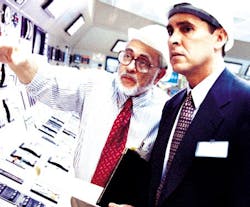Automation managers appreciate their wide-ranging value as predictive maintenance and inventory tracking tools, for example, or as asset life extension and return-on-asset monitors.However, more often than not, manufacturing managers, focused on running their production facilities, do not have the time or staff (especially these days) to research and evaluate all the asset management systems that might suit their company’s needs today…and tomorrow, let alone manage their installation and implementation.It is not a dollars-and-cents hesitancy; while asset management systems may come with a hefty price tag, they can pay for themselves in a relatively short time. The issue, too often, is that the best path to get there might not be considered.From a software perspective, all the big players offer commercial, off-the-shelf (COTS) packages. While these systems will deliver data and reports that are relevant and promise to reduce system development time and cost, there are recognized tradeoffs in terms of what you really need and the realities of your business practices. As well, their price tag is likely to drive you away.Most systems, though having canned front-ends and databases, are configurable to some degree and therefore can be customized specifically to your needs to provide the data wanted, and in the right format. The key here is that most available COTS systems are capable of delivering a lot of what you want, but maybe not everything you need, meaning that there are other factors that are more important to the project’s success. With systems becoming a commodity in this fashion, factors such as planning, design, development, integration and training become more critical to the success of the project than the technology itself.Because these software packages must be configured/programmed specifically to your needs, your company will need to employ the services of the software provider, an in-house programmer or an integrator to get exactly what you want. The first two choices will provide the software-centric answers you ask for; an integrator can provide more than that. This is especially true if you bring in an integrator early in the specification process.A good integrator brings most value when involved early in the process, before hardware and software have been selected. Most independent integrators are well tuned-in with the features and functionality of available software packages (and the instrumentation/sensing devices), will listen to the customer’s wants and needs, and can quickly guide the customer down the right path.Quality integrators are committed to putting the customer’s needs first, ahead of any manufacturer preferences, taking into account the existing installed base, spare parts inventory, maintenance personnel capabilities, operator interaction with the equipment and local support issues.Minimal frustrationThe goal of the integrator is to minimize the frustration and time associated with identifying the right package and to get you on the path to improved efficiencies faster. This means that the asset management system is in place sooner and pays for itself that much faster.Selecting the right technology partner to work with is the key to any automation project—more important than the technology selected to do the job.Michael Gurney, [email protected], is Executive Director of Concept Systems Inc., in Albany, Ore., a Control Systems Integrator Association Certified Member.
About the Author
Michael Gurney
Michael Gurney is co-CEO/vice president of sales and marketing at Concept Systems, a certified member of the Control System Inte
Michael Gurney
Michael Gurney is co-CEO/vice president of sales and marketing at Concept Systems, a certified member of the Control System Inte
Sign up for our eNewsletters
Get the latest news and updates

Leaders relevant to this article:
